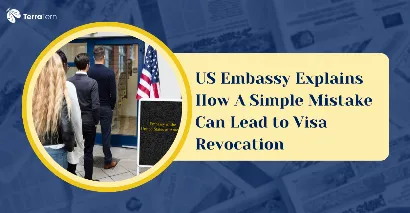Key Highlights
- Section 221(g) vs. Section 214(b): The Crucial Distinction
- The Nuances of a 221(g) Refusal: What It Means and How to Respond
- The Finality of a 214(b) Refusal: Navigating a New Path Forward
- Why Do These Refusals Happen?
- The Role of the Interview in the Decision
- Strategies to Avoid Refusals and Strengthen Your Application
- Conclusion
The jargon of a visa application can be a nightmare, and one wrong step can have severe ramifications. The embassy in India has clarified one of the most important differences between two frequently used types of visa refusals, 221(g) and 214(b). It is critical that a visa applicant understands the distinction between these two, since this will dictate the way forward and whether their visa application will be granted another chance. The blog post will explore these categories in a detailed manner, explaining what they entail, the reasons behind them, and how to manoeuvre the resulting phase.
Section 221(g) vs. Section 214(b): The Crucial Distinction
The main cause of confusion among the applicants is the distinction between these two parts of the refusal. Although both cases lead to denying a visa at the interview, their causes and the way forward are totally different. A 221(g) refusal does not constitute a final one, but it is a temporary barring of the application. It indicates that the visa officer will need more information or documents to be able to arrive at a final decision. It is like a pause on your application. This frequently occurs when a mandatory document is not available, the officer requires some additional administrative processing, or some security checks are required.
A 214(b) refusal, in sharp contrast, is a final and irreversible rejection of the visa in that particular case. This is a more severe finding in that there is a situational circumstance that is heavier in that the consular officer has established that the applicant never fit the eligibility criteria of the visa he sought. The most frequent cause of 214(b) denial is the inability to prove the existence of strong enough connections to their home country to convince the officer that they have good reasons to leave the United States rather than stay after their temporary visit. It is an intent assessment and a judgment call by the interviewing officer.
Also Read: How to Check Visa Rejection Reason? Experts Latest Guide
The Nuances of a 221(g) Refusal: What It Means and How to Respond
Upon receipt, the applicant is usually provided a special instruction on what to do next when he/she receive a 221(g) slip. This could include the presentation of an outstanding document, such as a document, a financial statement, an employment document, or a corrected application form. In other instances, the case is placed under administrative processing, which may take an unspecified time period.
The important point here is that the application has not been denied, and the visa can still be granted once the requested information has been submitted or the administrative process is over. Applicants are only given a maximum of a year to clear the issues, after which the application is automatically terminated. The applicant should pay attention to ensure that instructions are understood and that the necessary information is submitted promptly during this period.
The Finality of a 214(b) Refusal: Navigating a New Path Forward
A 214(b) refusal, however, means the final death of such an application. It is irreversible, and it takes more documentation to reverse it. The person will have to apply once again with a fresh beginning. It involves completing a new DS-160 form, paying the visa application fee once more, and applying for a new interview. The U.S. Embassy recommends re-applying only in cases where there has been a drastic change in circumstances that would enhance their case.
This can be new employment with better pay increments, promotions, a new house or property, or other significant events that show increased attachment to their home country. Unless things alter, in any case, there may be a repeat of the same application.
Also Read: Top 10 Visa Rejected Reasons: Know Latest Changes
Why Do These Refusals Happen?
Being aware of the frequent causes of visa denials can assist the applicants in being better prepared. In a 221(g) rejection, it is habitually an administrative oversight or mistake. A candidate may not carry with him a particular document, a copy of a passport photo may not pass the requisite specifications, or data on an application form may be misaligned. Most of the time, these are fixable problems.
Causes of the 214(b) refusal are less objective. They swirl around the intention of the applicant. Presuming (until proven otherwise) that every non-immigrant visa applicant is an intending immigrant is the work of the visa officer. It is up to the applicant to prove that he/she does not intend to stay long in the U.S. and that he/she has persuasive reasons to visit his/her home country. Such ties may be family, steady employment, house ownership, financial security, or other social or economic attachments. It can be said that a lack of such connections or the inability to state them clearly in the interview can result in a 214(b) denial.
Also Read: How Many Types of Visas are in the USA? New Full Expert Guide
The Role of the Interview in the Decision
The interview during the visa process is the most delicate aspect of the process. This is where the officer makes his/her decision. In both visa types, the impression made by an applicant and his/her response to questions may make a difference. To be nervous, to give inconsistent answers, or to be unable to express the purpose of travelling can serve as red flags. It is no longer merely the documents, but whether the applicant can comfortably and clearly explain his/her intentions and connections to the home country. It is recommended that the applicants be straightforward, concise, and prepared.
Strategies to Avoid Refusals and Strengthen Your Application
A 221(g) refusal may be mitigated by carefully proofreading the application form and by ensuring that all the required documents are ready before sitting down to fill in the application form. It is a necessity to recheck personal information in passports, confirmations about appointments, and any additional paperwork. In the case of a 214(b) refusal, it is even more important to prepare. Applicants are prepared to discuss their employment, family, financial status, and why they intend to go back to their native country. It is also prudent to carry some documents with you that could be later presented even when not requested by the officer.
Conclusion
Understanding the difference between 221(g) refusal and 214(b) refusal is one of the most essential facts a visa applicant should know about. A 221(g) is a temporary setback that can, in many cases, be resolved by patience and submission of additional information. This contrasts with 214(b), which is a decision that is considered final, and one is forced to seek a re-evaluation of circumstances first before a new application can be contemplated.
By being aware of these differences and properly planning the interview process, the applicants will multiply their opportunities for a successful outcome and evade confusion and frustration that could be caused by a visa rejection.
To stay updated about the latest immigration news, contact TerraTern right away!








